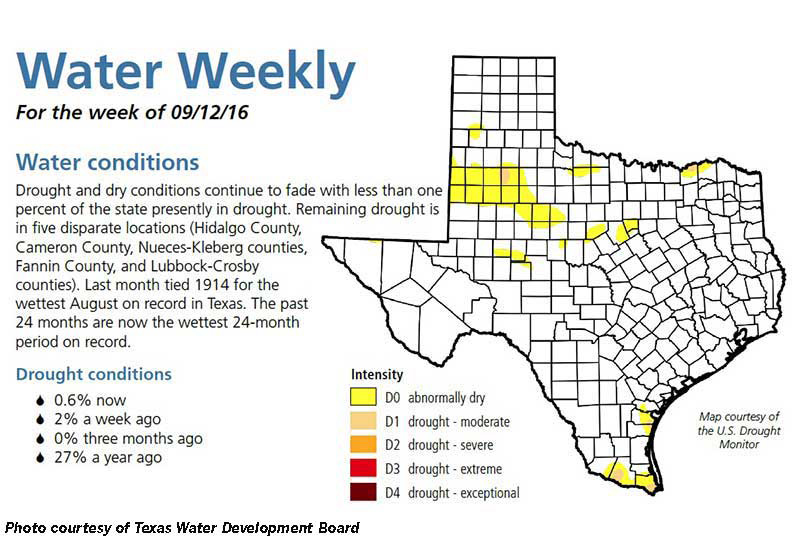Wet weather and cooler temperatures have helped relieve drought conditions across much of Texas.
Less than one percent of the state is currently experiencing drought or dry conditions, according to this week’s Water Weekly report from the Texas Water Development Board.
Counties at the tip of the Rio Grande Valley, in the Southern High Plains and in patchy locations along the Texas-Oklahoma border remain abnormally dry. Those counties include: Hidalgo, Cameron, Nueces, Kleberg, Fannin, Crosby and Lubbock.
This August tied 1914 for the wettest August in the state’s history.
The past 24 months are now recorded as the wettest 24 months in recorded history.
While the wet weather has benefited many, rains came at an inopportune time for cotton farmers in the Rio Grande Valley, Coastal Bend and North Central Texas. Rain fell on open bolls causing staining in the lint for most and seed sprouting.
“After a week straight of rain, by Aug. 22, the whole cotton industry was in a bit of panic with seed sprouting widespread across both regions,” Gaylon Morgan, Texas A&M AgriLife Extension service said in his Texas Row Crops Newsletter Sept. 6. “Unfortunately, the rain has continued to fall in some areas over the past two weeks, further decreasing fiber and seed quality and further delaying harvest.”
It wasn’t just the rain that caused problems, according to Morgan. It’s that the rainfall occurred over several days and did not give open bolls time to dry out. It provided a perfect environment for seeds to germinate.
After a few rain-free days, some areas were able to begin harvesting and ginning cotton.
“Ginners have their work cut out for them this year due to the weather, but as long as we make sure the lint and seeds are completely dried down, we shouldn’t have too many complications with ginning. Regrowth is still the main concern,” Xandra Morris, Texas A&M AgriLife Extension Agent and IPM for Hill County, reported.
In Hill County and other areas, there are reports of sprouting in both grain sorghum and corn.
“It may be a while yet before we know the extent of the damage,” Morris said.
Gins are also running along the Upper Gulf Coast, according to Kate Harrell, Texas A&M AgriLife Extension Agent and IPM for Jackson, Wharton and Matagorda counties.
“The big thing we need to watch for is making sure the lint and the seed are dry before picking (lint at 8 percent and seed below 12 percent). The wet seed sitting in a module could cause us issues down the road, as wet lint and seed can continue to degrade while sitting in a module,” Harrell said.
Although cotton looks bad in places, Harrell said seed and lint quality have been pretty good, considering the situation.
The full effect the wet weather will have on Texas cotton remains to be seen.
“The hope is that the quality isn’t going to be as bad as expected,” Morgan said. “But the gins haven’t ginned much of the damaged cotton at this point and we won’t know the level of lint and seed discounts until then. The take-home message is that we need to give these cotton fields every opportunity to allow the lint and seed to dry down and ‘bleach-out’ some of the stains. Otherwise, putting high moisture seed cotton into a module will further degrade lint and seed quality while the modules are waiting to be ginned.”
A full crop report from Texas A&M AgriLife can be found here: http://today.agrilife.org/2016/09/07/texas-crop-weather-report-sept-7/.

